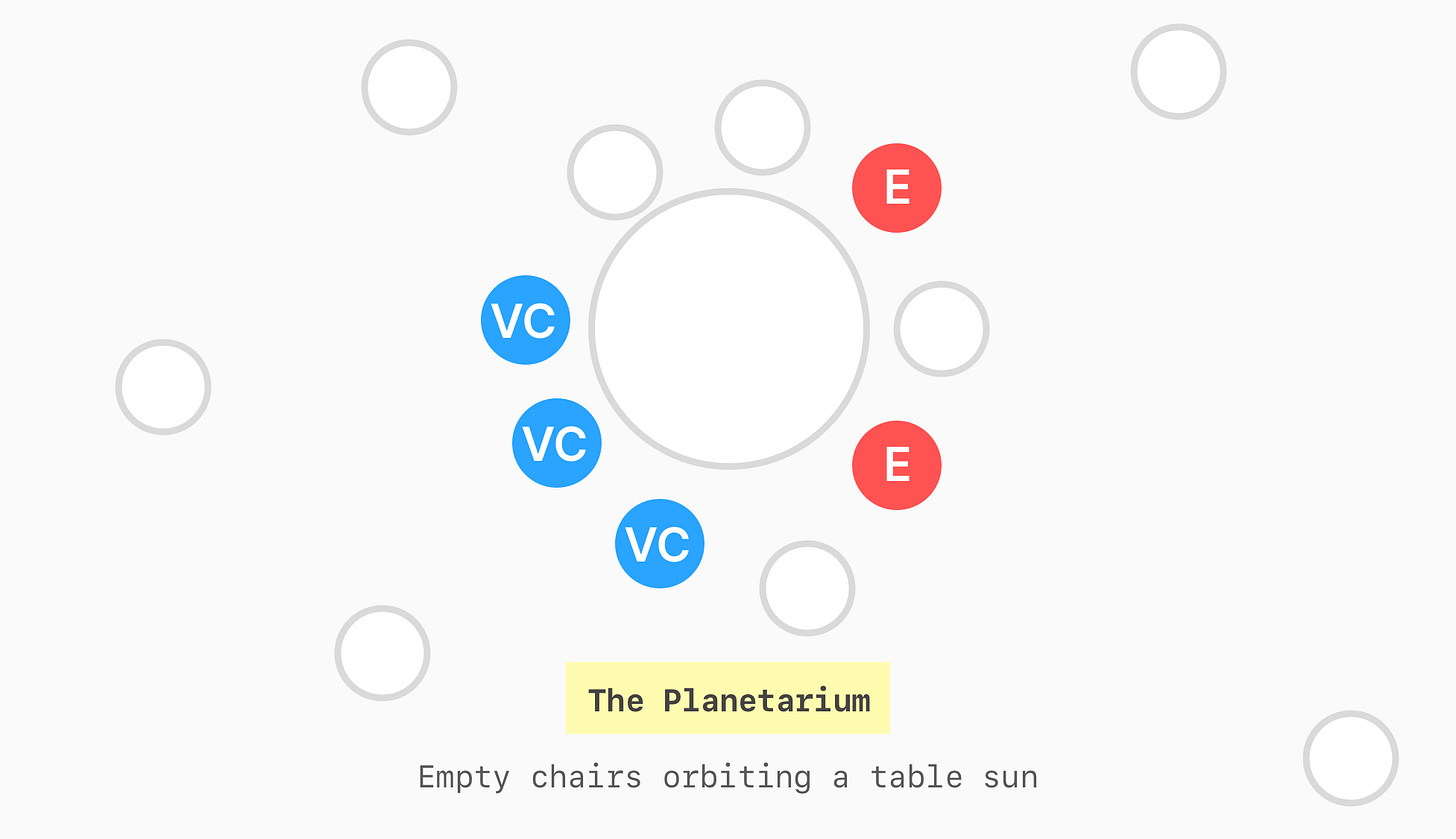Investor Meeting Seating
Despite the outsized impact room-layout can have on investor outcomes, their configuration is often haphazard. I have been documenting my findings for you.
(This post was originally published on 04.10.19)
We just finished YCombinator. Surrounding Demo Day, we went to a lot of investor meetings. Such conversations are usually well-choreographed and methodical but their physical conditions can be variable and random. The following will massively (though subtly) impact the flow of a meeting
1. Furniture
2. Room layout
3. Where people sit
Despite the outsized impact the above can have on the outcome, their configuration is often haphazard. I have been documenting my findings for you.
Before I continue, I should mention that I think a lot about seating. I spoke to NPR once about where to sit at dinner. Maybe I think about it too much.
My previous article outlines basic tactics for unassigned seat selection at the dinner table. Pitch meetings aren’t usually held at a dinner table (thankfully), but many of the same seating principles apply. Investor meetings introduce notable differences:
Table size is rarely optimized for party size
Conversation is semi-structured, as opposed to freeform
There are two “sides” (and sometimes one is outnumbered)
Here are some of the configurations we’ve encountered so far:
The Bistro
This is a simple and common seating arrangement. However, it’s rare to see a meeting room with a tiny layout like this in an office. More often, these are encountered off-site, where noise conditions and crowd dynamics are dangerously unpredictable and volatile.
The Casual Friday
This array can work pretty well, but there is only one appropriate seating arrangement (shown). It’s easy to get this wrong – for example, if only one person sits on the couch, it can feel like they’re in trouble. (Worse: everyone could sit on the couch.)
The Planetarium
It’s difficult to know where to sit in a room like this, due to the awkwardness of sitting directly next to someone you’ve just met. Therefore, empty chairs are used as comfort-spacers, which create unnaturally long distances between parties.
The Awkward Line
This shouldn’t happen, but it can (sometimes as a result of the door’s position, and entry timing). If it does, it’s extremely awkward for the person in the middle of the conversation. It’s worth excusing yourself and reentering if this occurs.
The Job Interview
There are two things going on here: a weird room layout (confrontational array) and bad positioning of the remote participants. Remote participants are inevitable, but they should be positioned with eye-lines in mind.
The Tear Drop
Of the conditions I’ve seen so far, this was my favorite. The table’s unexpected and natural shape puts all parties at ease and obliquely prevents confrontational discussion angles. I’d never seen a tear drop table before, but it was the best.
The I Thought The Meeting Was Today
At least you “got the time back”, as we used to say at Facebook.
The Hard to Schedule
As intimidating as this looks, it’s actually perfectly optimized for what it is (a full partner meeting). That’s the key: the space should be optimized for the conversation that’s going to take place inside.
—
There were countless other arrays but mostly just variations on the above themes.
Pitch meetings are not normal meetings; the conditions in which they occur should be hyper-considered. As we’ve seen, if they’re not, the collateral impact on the dynamics of the conversation can range from plain awkwardness to subconscious adversariness.
Both investor and entrepreneur have honed their performances – the conversation itself – over many years. Each side knows exactly how to execute their part in the pitch meeting dance. But the stage itself – the meeting room – lags woefully behind in terms of optimization. This is an opportunity!
The best restaurants understand how physical conditions impact experience. The same should apply in the meeting room. The conditions should be optimized. Dialed-in.
If I were an investor, I would think about this a lot. Which is probably why I’m not an investor.
But if you are, perhaps this was helpful.












Love this! ❤️